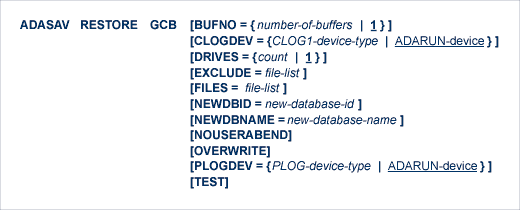From a database SAVE data set created while the Adabas nucleus was inactive, the RESTORE GCB function restores
the general control blocks (GCBs);
Associator RABNs 3-30 of the database;
the checkpoint file;
the security file (if present); and
all files specified with the FILES parameter.
Notes:
This document covers the following topics:
![]() To use the RESTORE GCB function, the following conditions must be
met:
To use the RESTORE GCB function, the following conditions must be
met:
The correct SAVE data set must be supplied. It must have been created by an offline database SAVE operation with the same version of Adabas as is used for the RESTORE and must contain the file(s) to be restored.
The output database must have the same physical layout (device types, extent sizes) as the original database. The Associator and Data Storage data sets must be present and must have been previously formatted. The SAVE data set to be restored may have originated for this or from a different database.
No Adabas nucleus may be active on the output database or on a database with the DBID of the output database.
If the SAVE operation was performed with the DRIVES parameter, the SAVE data sets created can also be restored with the DRIVES parameter. In that case, the restore operation is performed from the different SAVE data sets in parallel. Alternatively, the SAVE data sets can be concatenated to a single SAVE data set for a restore operation without the DRIVES parameter.
For restoring just a few files from a multivolume database SAVE data set, only those tape volumes that actually contain data of the files to be restored need to be supplied in the ADASAV job control. The job protocol of the SAVE operation as well as the corresponding SYNV checkpoints indicate the files or parts of files contained on each volume.
The result of this function is a database containing the specified files and the checkpoint and security files with the same physical status they had at the time of the ADASAV SAVE operation.
This operation is equivalent to a RESTORE (database), but excludes any files not specified in the FILES parameter.
Important:
Any existing database in the target Associator and Data Storage
data sets is completely overwritten and any files in that database are
lost.

The BUFNO value, multiplied by the DRIVES parameter value, allocates fixed buffers for RESTORE operation. A value of 2 or 3 usually provides optimum performance; up to 255 is possible. A value greater than 5, however, provides little advantage and allocates a lot of space. The default is 1 (one buffer per drive).
The device type of the command log (CLOG). This parameter is required only if the device type of the CLOG is different from that specified by the ADARUN DEVICE parameter.
DRIVES is the number of tape drives to be used for parallel restore processing. The number can range 1 to 8, inclusively; the default is 1.
EXCLUDE lists the numbers of the files to be excluded from the restore operation; that is, the files that are not to be restored.
No files specified in the EXCLUDE parameter will exist in the restored database.
All files specified in the EXCLUDE parameter must exist on the save data set.
The parameter is optional: if not specified, no files are excluded. A file number may be listed only once.
The EXCLUDE parameter is provided for use in recovery jobs built by the Adabas Recovery Aid (ADARAI).
FILES specifies the file or files to be included in the database restore operation. If the specified file is a component file of an Adabas expanded file, all other component files of the expanded file must also be specified here. If a specified file is coupled to other files, the coupled files must also be specified. The checkpoint and security files are always restored.
NEWDBID may be used to assign a different database ID to the restored database. The ID can be in the range 1-65,535; if Adabas Online System Security is installed, DBID 999 is reserved.
If NEWDBID is specified, the ADARUN DBID parameter must specify the ID of the database on the SAVE data set.
No Adabas nucleus may be active with the DBID specified on NEWDBID.
NEWDBNAME assigns a new name to the restored database. If NEWDBNAME is not specified, the restored database keeps its old name.
When an error is encountered while the function is running, the utility prints an error message and terminates with user abend 34 (with a dump) or user abend 35 (without a dump).
If NOUSERABEND is specified, the utility will not abend after printing the error message. Instead, the message "utility TERMINATED DUE TO ERROR CONDITION" is displayed and the utility terminates with condition code 20.
If the restore operation is to overwrite an existing database, the OVERWRITE parameter must be specified.
No Adabas nucleus may be active on the database to be overwritten.
The device type of the dual/multiple protection log (PLOG). This parameter is required only if the device type of the PLOG is different from that specified by the ADARUN DEVICE parameter.
The TEST parameter tests the operation syntax without actually performing the operation. Only the syntax of the specified parameters can be tested; not the validity of values and variables.
ADASAV RESTORE GCB,FILES=2,4,6,8
The database Associator GCBs, RABNs 3-30, the checkpoint and security files, and files 2,4,6, and 8 are to be restored.
ADASAV RESTORE GCB,FILES=3,4,5,OVERWRITE
The Associator's GCBs and files 3, 4, and 5 are to be restored; the existing database will be overwritten.